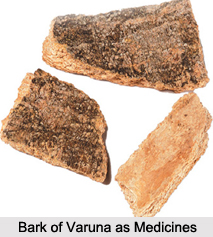 In Ayurveda, the bark of the Varuna has been traditionally used to heal kidney stones for more than 3,000 years. The bark of the stem and root of this plant constitutes the principal medicine of the Hindu Pharmacopoeia, for calculous affections. It is said to promote the appetite, increase the secretion of the bile, act as a laxative and remove disorders of the urinary organs.
In Ayurveda, the bark of the Varuna has been traditionally used to heal kidney stones for more than 3,000 years. The bark of the stem and root of this plant constitutes the principal medicine of the Hindu Pharmacopoeia, for calculous affections. It is said to promote the appetite, increase the secretion of the bile, act as a laxative and remove disorders of the urinary organs.
Dose of Varuna in Medicine
In calculous affections it is used in a great variety of forms. Thus a simple decoction of the bark may be given with the addition of treacle. A compound decoction is prepared along with equal parts, of Tribulus terrestris (Gokshura) and ginger and is administered with the addition of yavakshara and honey.
A compound powder called "Varunadya Churna" is prepared as follows; a solution of the ashes of varuna is made as directed under the heat of alkaline water (Ksharodaka). This solution is boiled with the addition of varuna bark in powder and yavakshara (impure carbonate of potash), till the water is entirely evaporated. The resulting powder is given in ascites, calculus, enlargements of the abdominal viscera and affections of the bladder and uterus. A confection called "Varunadya Guda" is prepared by adding to the fluid extract of the bark, treacle and a number of diuretic and aromatic substances.
In scrofulous enlargement of the glands under the lower jaw, a decoction of varuna bark is prescribed by several writers. It is said to cure even old standing cases. In internal or deep seated suppurative inflammation, a decoction of varuna and Boerhaavia diffusa (punarnava) is given internally.
Varunadya Ghrita
Varunadya Ghrita: Take of coarsely powdered varuna bark 12 seers and a half, water 64 seers, boil together till reduced to one-fourth and strain. To the strained decoction, add 4 seers of clarified butter and 2 tolas each of the following substances in the form of a paste, namely; varuna bark, unripe plantains bela fruit, the 5 roots called trinaja pancha mulaka, gulancha, leaves of Coleus aromaticus (asmabheda), cucumber seeds, Acorus calamus root, bamboo-manna, the ashes of Sesamum Indicum (tila) and of Butea frondosa (palasa) and the root of Jasminum auriculatum (juthika). Boil them together and prepare a ghrita in the usual way. It may be given in doses of 1 to 2 tolas, according to the constitution of the patient. After this medicine is digested, buttermilk and treacle should be taken.
Varunadya Taila
Varunadya Taila is an oil prepared with varuna bark, for injection into the bladder. To prepare this oil: Take varuna bark and of the entire plant of Tribulus terrestris (gokshura), 2 seers each, water 64 seers, boil together till reduced to one-fourth and strain. Boil this strained decoction with 4 seers of prepared sesamum oil and half a seer each, of the above mentioned drugs in the form of paste. This oil is recommended to be injected into the bladder, for the relief of painful micturition, calculus and gravel.
Related Articles
Ayurveda
Origin of Ayurveda
Ayurveda Medication
Elements of Ayurveda
Concepts of Ayurveda
Ancient Literature of Ayurveda
Classification of Medicine





